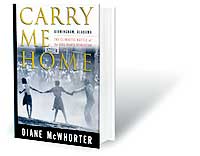
A Long Road to Justice
The climactic battle of the civil rights struggle
|
||
As a murder trial approaches for Bobby Frank Cherry, 71—accused in the 1963 bombing of a church in Birmingham, Alabama, that killed four girls—a renewed lesson can be drawn from events that defined the civil rights movement and justice for African-Americans.

| ||

n Carry Me Home, author Diane McWhorter’s memories of growing up in Birmingham in the 1950s and 1960s are interwoven into the complex history of race relations in Birmingham, Alabama, in a way that makes it real and personal. But the book has the scope of several histories, depicting the long story and many characters in the drama of integration.
Industrialists like U.S. Steel and the coal interests of the DeBardeleben family who built the city sought industrial growth and riches for the bosses (the “Big Mules”), and ever-increasing profits through cheap labor. African-Americans were the cheapest available, although plenty of poor whites worked at the factories and mines as well.
In the 1920s, as the labor movement was growing, the Big Mules in Birmingham needed a way to fight the unions to keep black and white workers from joining forces.
Thus mine owners financed the resurrection of the long-dead Ku Klux Klan to divide the workers. The resulting chronicle of hatred and injustice is almost overwhelming.
During one of the most intense periods of racial strife in the Birmingham of the 1960s, police worked arm in arm with the Klan; the police chief notified the Klan that they would have 15 minutes to meet the Congress of Racial Equality’s Freedom Riders at the bus station before the police arrived. When a photographer took a picture showing the face of a Klansman as he beat an African-American man in that bus station, it was the photographer who was arrested.
The Klan’s violence had also turned deadly. In the neighborhood known as Dynamite Hill, homes of blacks aspiring to the middle class were blown up by Klansmen.
In one instance, Roosevelt Tatum, an African-American resident of the area, reported to authorities that he had seen two policemen leave a package on the steps of Rev. A.D. King’s home and then saw something tossed from their car onto the lawn. Two quick explosions followed. Tatum was the only person imprisoned in any of the Birmingham bombings until 1977, when “Dynamite Bob” Chambliss, a local Klansman, was convicted of the 1963 church bombing that killed four girls.
Tatum was convicted of lying to the police about the bombing he had witnessed.
In 1979, Freedom was the first publication to examine Tatum’s story in depth, as well as the efforts of Dan Moore, a federal marshal, to exonerate Tatum from false charges*. Moore was eventually dismissed because of those efforts. This story is just one of the many inequities documented in Carry Me Home.
Parallel to the injustices in Birmingham were those at the hands of the Federal Bureau of Investigation. FBI officials protected their mole in the Klan, Gary Thomas Rowe, and retained him as an informant even when they knew he had participated in repeated acts of racial violence.
Behind the FBI’s malfeasance was J. Edgar Hoover, whose profession as a hunter of subversives had been launched by U.S. Steel. According to McWhorter, “To squelch the union movement among its workers in 1919, [U.S. Steel] had helped foment the Red Scare that led Congress to create an anti-radical general intelligence division of the Justice Department. Hoover was appointed its first chief....”
When the Kennedy administration advised Hoover’s department to aid the integrationists, Hoover instead wiretapped Rev. Dr. Martin Luther King Jr. and his associates and accused them of being communists. He wasn’t about to buck U.S. Steel.
As described by the author, there was so much corruption at every level of society that it seems a miracle that the civil rights movement survived.
But it did, and thus Carry Me Home is also a story of spiritual triumph. From the beginning, ministers in the African-American churches of Birmingham preached the gospel of freedom, organized their congregations and built the groups that would eventually join forces to overcome segregation.
The author’s progress from a child of racism into a chronicler of the freedom movement echoes the history of her city and the individual tales of the bombing’s four suspects.
One, Robert Chambliss, convicted in 1977, died of cancer in prison eight years later. Another, Herman Cash, died in 1994 before being charged.
In 2001, McWhorter writes, “It seemed that Birmingham’s white people might finally rid themselves of their burden of collective guilt. Bobby Frank Cherry and Tommy Blanton, the last two living suspects in the BAPBOMB [FBI code for the Baptist Church bombing] file, were charged with murder in the bombing of the Sixteenth Street Baptist Church.”
In January 2002, Cherry was declared competent to stand trial, scheduled for the end of April.
Carry Me Home is an epic that chronicles some of the most shameful events of American history, while portraying the triumph of the civil rights movement—one that is still being realized today.
* “Birmingham 1963,” Freedom, June 1979.

